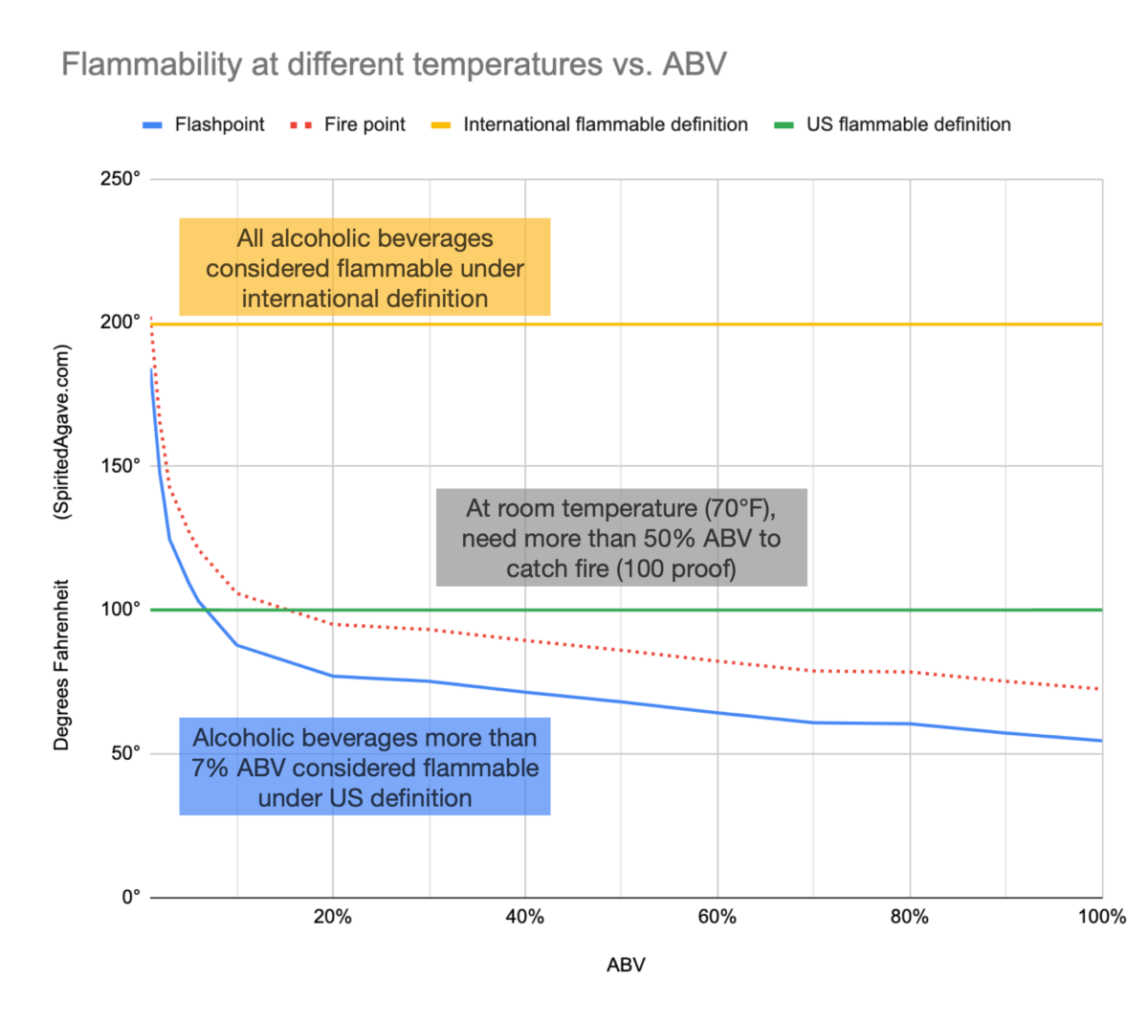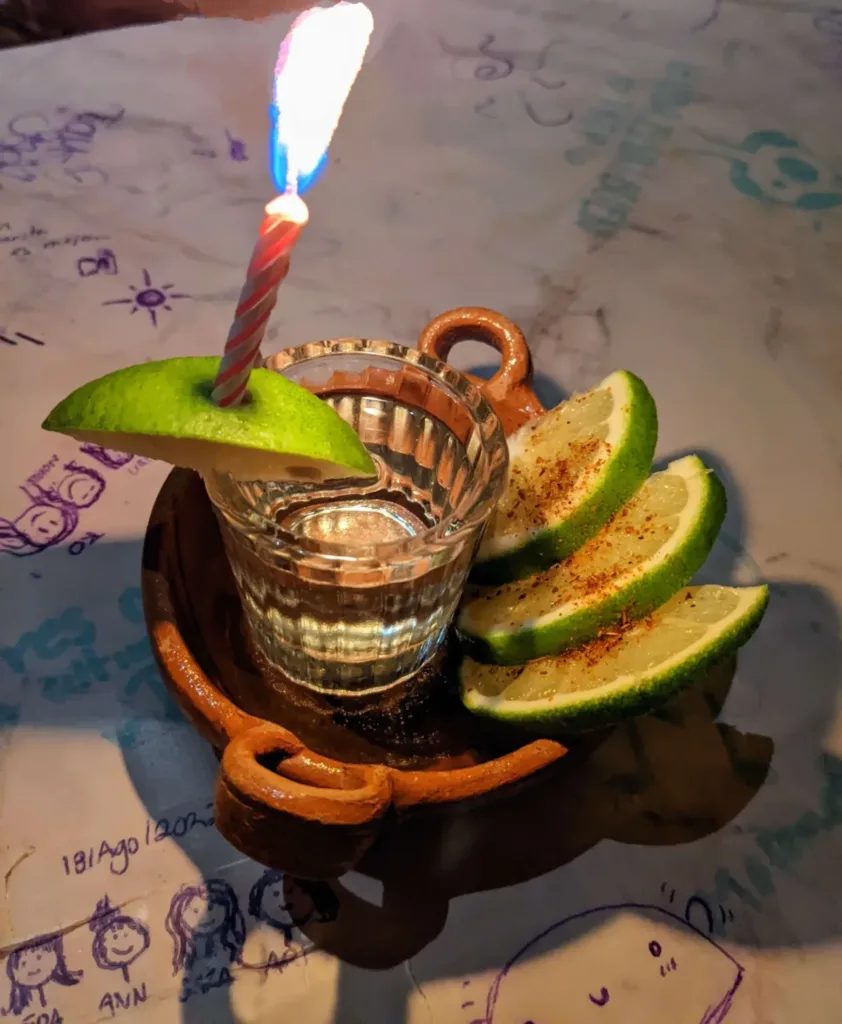Yes tequila is considered flammable by the official definition, but you won’t be able to light a shot on fire unless you heat it first. Even the strongest tequila available needs to be preheated to produce an ongoing fire.
I’m a curious sort and prefer to dig beyond the obvious and learn more about what makes tequila flammable, and what happens when you heat or light tequila on fire. From this perspective tequila is not really different from other spirits, so the same lessons apply to the flammability of vodka and whiskey for example.
Safety message: You should be very careful when attempting to light alcohol on fire, especially very high proofs. Bacardi 151 (151 proof) was apparently taken off the market due to the large number of lawsuits the company encountered from people burning themselves when using it for flaming.
Table of Contents
What is considered flammable?
In the US liquids that can ignite at temperatures up to 100 °F (37.8 °C) are considered flammable. Internationally there are different standards administered by the UN. Under UN standards liquids that can ignite at temperatures up to 199.4 °F (93 °C) are considered flammable.
“A flammable liquid is defined as a liquid whose flash point does not exceed 100°F”
NFPA 30
Until 2012 all US bodies followed the US standards for flammability. Now different agencies use different standards. For example the Department of Transportation (DOT) applies UN standards while the National Fire Protection Association (NFPA) still uses the US standards.
What does flash point mean?
The flash point for a liquid is the lowest temperature where it can still catch fire if lit from a flame. Another related but different term is the “fire point”. The fire point is the lowest temperature at which the liquid keeps burning for five seconds after the ignition source (i.e. flame) is removed.
The fire point of a liquid is always a higher temperature than its flash point. The fire point is generally around 10 °C higher than the flash point.
The official definition of flash point is:
“lowest liquid temperature at which, under certain standardized conditions, a liquid gives off vapors in a quantity such as to be capable of forming an ignitable vapor/air mixture”
International Electrotechnical Commission.
Flammability of alcohol at different temperatures
The likelihood that alcohol with catch fire (flash point) and stay on fire (fire point) depends on the alcohol content and the temperature of the liquid. At high enough temperatures just about any alcoholic beverage will catch fire.

Is tequila flammable?
Yes, tequila is flammable but you may still struggle to be able to light it on fire. Tequila is considered flammable because it has a flash point (meaning it can catch fire) lower than the official cutoff level of 100 °F (37.8 °C). Which is also much lower than the UN’s official cutoff level of 199.4 °F (93 °C).
The alcohol in tequila and other spirits is ethanol. 100% pure ethanol has a flash point of 54.5 °F (12.5 °C), meaning it will catch fire at temperatures as low as 54.5 °F, well within the temperature ranges required to be considered flammable.
Technically it’s the vapor that is evaporated from the liquid that catches fire, not the liquid itself.
Flammability of standard 40% tequila
A standard tequila has 40% alcohol by volume. A 40% ethanol mix has a flash point (will catch fire) at temperatures as low as 71.5 °F (21.9 °C). Again this is well within the level required to be considered flammable. However this is around room temperature, so if you’re in a slightly cool room you probably won’t be able to light tequila on fire.
Will tequila catch fire?

Tequila needs to be heated first in order to remain on fire. Tequila and other standard poof spirits will not catch fire at room temperature. As mentioned above, it’s not just the flash point that’s relevant, but the fire point.
If you are trying to flame a shot for example, you want it to continue to burn after you remove the lighter. The fire point is the level where the liquid will continue to burn for at least five seconds.
Standard 40% ABV tequila and spirits
The fire point is generally 10 °C higher than the flash point, meaning the fire point for a standard 40% ABV tequila or spirits is about 90 °F (32°C). In order to get 40% ABV tequila to flame, the temperature needs to be raised to 90 °F or more. Ideally significantly more given you will not be in lab conditions and the liquid will cool fairly quickly.
Strongest 55% ABV tequila
Tequila at 55% ABV is the strongest allowed by Mexican regulations. Anything stronger than that and it can’t be called tequila. At 55% ABV the flash point is 66 °F (19 °C) so the fire point is around 84 °F (29 °C). Even the highest proof tequila will need to be heated first to maintain a flame.
Why do you need to heat tequila and other spirits first to light it?
At lower temperatures, the alcohol vapors given off are not sufficient to support a flame. A flame may ignite at first, but quickly burn out as the rate of vapor release is not enough to offset the vapor that is burned.
One technique is to heat a small amount of tequila in a bar spoon by first holding a lighter underneath, and then lighting the liquid after it has warmed up. Alternatively, heat the entire shot in a microwave for a few seconds.
What happens when liquor burns?
When liquor burns it is the vapor released by the liquid that catches fire, not the liquid itself. Alcohol burns with a blue flame, which is from the ethanol. Spirits like tequila and vodka release vapor as they evaporate.
Evaporation is caused by the kinetic energy of molecules at the surface of a liquid. When the molecules gain enough energy they are released. More surface area will mean more evaporation. Likewise a higher temperature will also increase evaporation.
When you hold your nose to a glass of tequila, you are smelling these vapors. Spirits, like all liquids, evaporate (release vapors) at all temperatures but more so at higher temperatures. Hence, increasing the temperature of the spirit increases the likelihood that it will catch fire and burn if ignited.
Chilling, or freezing tequila reduces the aromas and taste.
Is tequila more flammable than vodka?
When it comes to flammability of different types of liquors, by far the main driver is alcohol content. Tequila and vodka of the same alcohol percentage have the same level of flammability. In the US the standard ABV for both tequila and vodka is 40%, so most are equally as flammable.
There are restrictions on the maximum ABV of tequila at 55% (110 proof), but there are no restrictions on the alcohol content of vodka. So the highest proof vodkas (e.g. Devil’s Springs Vodka is 151 proof, or 75.5% ABV) are more flammable than the highest proof tequilas.
151 proof alcohol, like the previously popular Bacardi 151 (RIP 1962-2016), can ignite at just 60 °F (15.9 °C) and will maintain a flame at 79 °F (25.9 °C).
What percent alcohol is flammable?
Drinks with alcohol volumes above 7% are considered flammable according to US definitions. This means that all spirits, liqueurs, wines and even some beers are considered flammable.
The UN official definition for flammable liquids is even broader. Under UN classifications all beers and light beers are considered flammable. In fact, even drinks with just 1% ABV would technically be considered flammable (flash point 184 °F (84.5 °C). This is because their flash points are below 199.4 °F (93 °C).
What proof does alcohol burn?
At room temperature alcohol will ignite at around 90 proof (45% ABV) however the flame won’t last long. For a flame to burn for a few seconds alcohol needs to be closer to 140 proof. Alcohol will burn at lower proofs if heated first, or lit by a blow torch rather than a match or ordinary lighter.
What is the most flammable alcohol?
The most flammable alcohols are those with the highest alcohol content. The spirit with the highest alcohol content, and therefore the most flammable, is Polmos Spirytus Rektyfikowany from Poland. It is 192 proof, or 96% ABV. Close behind is Everclear, at 95% ABV or 190 proof.
The flash point for these spirits is about 56 °F (13.5 °C), meaning they will easily catch fire except at cold temperatures.
Does burning alcohol make it weaker?
No, burning alcohol does not directly make alcohol weaker, but heating alcohol will reduce its strength over time. This is because the flame is only burning the vapor, not the liquid itself. The alcohol content will only go down due to evaporation or boiling, not because of the flame.
However the flame may increase the temperature of the liquid, either directly, or by heating up the vessel, e.g. shot glass. Alcohol evaporates more at higher temperatures. So the higher the temperature, the bigger the surface area, and the longer it is exposed to heat, the more the alcohol will reduce.
In this release from the USDA, flaming alcohol was found to reduce alcohol content by 25%. The exact method is not shown but we know that the reduction is likely due to the secondary heating effect, rather than from the flame itself. The same study shows just leaving the alcohol out overnight reduces the alcohol content by 30%.
Does heating alcohol make it weaker?
Yes, heating alcohol will reduce its strength over time. This is because more alcohol vapor is released at higher temperatures. The amount of reduction depends on how strong and how long you heat, and the surface area (e.g. a wide frying pan will more effectively reduce alcohol content than a narrow saucepan).
For example, this study showed the amount of alcohol reduction could be as great as 95% for stews that simmered a long time, versus just a 15% reduction for sauces brought quickly to the boil then removed from heat.
In all cases some level of alcohol remains after heating or cooking. Heating for shorter periods of time will not remove all alcohol, neither will burning it.
| Simmering / stirring time | Proportion alcohol reduction | Based on 40% ABV starting point |
|---|---|---|
| At start | 0% | 40% |
| 15 minutes | 60% | 16% |
| 30 minutes | 65% | 14% |
| 1 hour | 75% | 10% |
| 1.5 hours | 80% | 8% |
| 2 hours | 90% | 4% |
| 2.5 hours | 95% | 2% |
The exact alcohol reduction will depend on the surface area of the pan and level of stirring, so these should be taken as broad guidelines.
More spirit science posts
- Learn about the pH of tequila, vodka, gin and other beverages and what this means for your health
- Now you’re an expert on heating spirits, find out about freezing them
